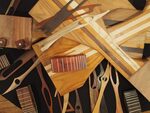We may receive a commission when you use our affiliate links. However, this does not impact our recommendations.
Teaching is a two-way street. It’s not just for students. As an instructor, you get to peek into the many different ways students use their tools. Since one of the things I teach is digital woodworking, after much observation and conversation a number of patterns have emerged about CNC setup.
The first is that the majority of CNC owners move their origin points for each project, task or run. (The origin point is where X, Y, and Z intersect. Everything is then reset to to X = 0 and Y = 0.) This is the position you align your CAD drawing with the material you’re machining. Typically, this would be located at a corner or the center of your raw material.
The second thing I’ve observed is that most CNC users either don’t have or use accurate, fixed positions on their bed. The third pattern I’ve noticed is part holding is usually done on the fly rather than with a consistent method or setup. Unless the CNC has T-track on the bed, a lot of people either screw or double-stick tape their parts down.
Make use of CNC accuracy
These three observations merge into a single key point: most CNC users are not using the available accuracy and power of their equipment to their advantage when it comes to easy and accurate setup, repeatability and improved part holding.
So, the obvious question is: what can a digital woodworker do to fix this? The answer involves a number of steps, but it all starts with establishing a repeatable set up between the CNC movements and positions in the physical world. You do that with the machine’s “home position” — if your CNC has one, and/or add a fixed position on the CNC’s bed. I use both. The video above shows you the home routine and a fixed reference point on my CNC.
In the video, I show how my CNC finds its home position and how I established a physical reference point on its bed. Once you have a connection between the CNC and the physical world, you have a repeatable position you can refer to and use as a reference point for additional positions on the bed to speed up part alignment and to secure holding. In my next installment, I’ll show you how my custom CNC is setup. Down the road, I’ll show you how to do the same with your CNC.
Additional Resources
- Digital Woodworking on Instagram
- Personal Work on Instagram
- Digital Woodworking YouTube Channel
Here are some supplies and tools we find essential in our everyday work around the shop. We may receive a commission from sales referred by our links; however, we have carefully selected these products for their usefulness and quality.









